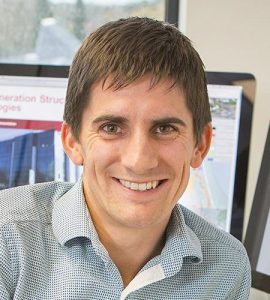Speaker: Brendon. A. Bradley
Affiliation: , University of Canterbury, New Zealand

Brendon Bradley, Professor of Earthquake Engineering at The University of Canterbury, New Zealand, will present: “Engineering aspects of the recent 14 November 2016 Mw7.8 Kaikoura. New Zealand earthquake“.
Summary:
On 14 November 2016 at 12:02 AM local time, the magnitude Mw7.8 Kaikoura earthquake occurred along the east coast of the upper South Island, NZ. It was the largest recorded earthquake in NZ since the 1855 Mw8.2-8.3 Wairarapa earthquake. This presentation will address scientific and engineering aspects of the earthquake that have been canvased to date, as well as emerging issues that continue to surface related to the natural/built environment and societal implications.
The earthquake initiated in the Waiau Plains in North Canterbury, and involved multiple fault segments (at least 10) as the rupture generally propagated northward over 150km to Cape Campbell in Marlborough. Given the geographical proximity of the earthquake in a largely rural region of NZ, the impacts in the near-source region were largely geological and geotechnical in nature, namely surface rupture, landslides, and localized ground failure, resulting in damage to coastal transportation infrastructure and the formation of landslide dams.
Significant damage occurred to State Highway 1 (SH1) both North and South of Kaikoura and the inland Kaikoura road (SH70) from landslides and slope instability – the northern SH1 section affected is estimated to be closed for one year, leading to substantial disruption to commercial and public transportation along the island’s main highway. Relatively significant damage also occurred to numerous structures in the capital city of Wellington (located approximately 60km to the North of the causative faults) – one structure had a partial collapse of precast floor units and is the subject of an on-going government enquiry, while another three structures are undergoing rapid demolition.
As of mid-December 2016, 11% of Wellington office space was closed due to damage.
Biography:
Brendon is a Professor of Earthquake Engineering in the Department of Civil and Natural Resources Engineering at the University of Canterbury, New Zealand; and the Deputy Director of QuakeCoRE: The New Zealand Centre for Earthquake Resilience, which is a network of over 180 active researchers. His areas of interest include engineering seismology, strong ground motion prediction, seismic response analysis of structural and geotechnical systems, and seismic performance and loss estimation methods. He obtained his Bachelor of Engineering with Honours in 2007 and PhD in 2009. Prior to joining the University of Canterbury in 2010, Brendon worked at GNS Science in Wellington, New Zealand, and as a post-doctoral fellow at Chuo University in Tokyo, Japan. Brendon is an editorial board member for EERI’s Earthquake Spectra and the Bulletin of the New Zealand Society of Earthquake Engineering. Brendon has received several notable awards for work with collaborators, including, the 2012 Ivan Skinner EQC award for the advancement of earthquake engineering in NZ; 2013 Royal Society of NZ Rutherford Discovery Fellowship; 2014 Shamsher Prakash Foundation Research Award; 2014 NZ Engineering Excellence Awards Young Engineer of the Year; 2015 University of Canterbury Teaching Award; 2015 TC203 Young Researcher Award; 2015 EERI Shah Innovation Prize; 2016 ASCE Norman Medal; and 2016 New Zealand Prime Minister’s Emerging Scientist Prize.
Date/Time:
Date(s) - May 16, 2017
4:00 pm - 5:00 pm
Location:
Kinsey Pavilion 1200B
Kinsey Pavilion Los Angeles CA 90095
